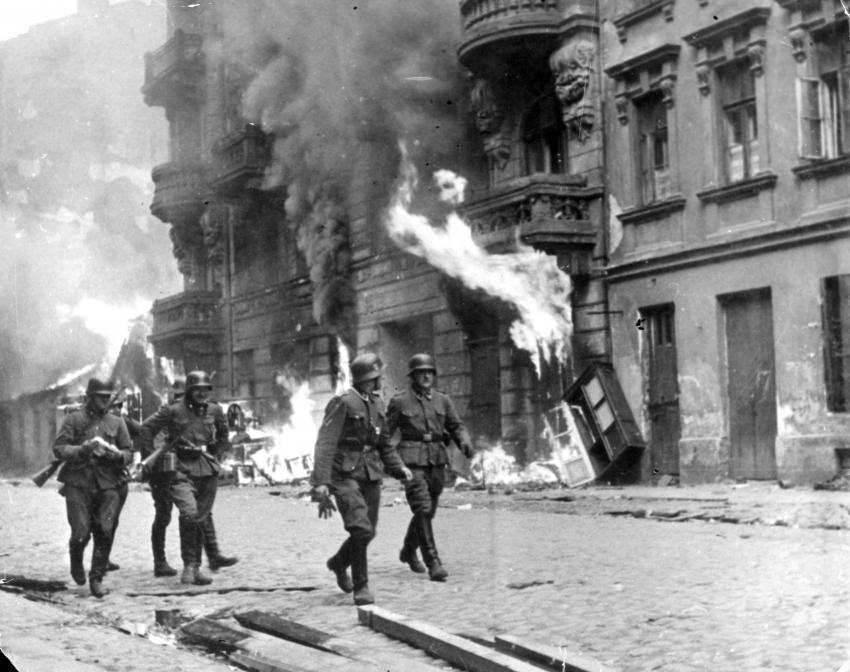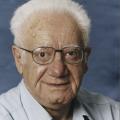
Warsaw, Poland, 1943, General Stroop's men next to burning buildings during the suppression of the uprising
Yad Vashem Photo Archives 2807/65
Generation after generation, Jews and non-Jews alike confront the greatest crime ever perpetrated against humanity — the Holocaust. Overwrought, individuals and nations try to comprehend how the largest and most vibrant Jewish settlement that thrived in Europe for a millennium was eradicated in a matter of years.
Just as Jewish fate differed from that of other nations under Nazi rule, so too did the nature of Jewish opposition to the Nazis. Out of the sheer will to survive, millions of persecuted Jews in Nazi Third Reich territory and the occupied countries resisted the Nazis. On the eastern and western fronts, hundreds of thousands of Jews fought and died in Allied Armies.
“Operation Barbarossa” — the German invasion of the Soviet Union on 22 June 1941 — marked the beginning of the mass murder of Jews in eastern occupied areas. Upon hearing of the mass shooting of Jews in Ponary and other sites, Zionist youth movement activists in Vilna were first to comprehend the Nazi intent: to utterly and completely annihilate the Jews.
The warning cry issued from Vilna spurred initial thoughts of ghetto revolts for thousands of young Jews, particularly members of the clandestine Zionist-pioneer youth movements. In ghettos such as Bialystok, Krakow, Bendin, Czestochowa, and Tarnov rebellions and confrontations broke out during the final deportations. These desperate acts of resistance were a display of the triumph of the Jewish and human spirit, a cry for life, and a banner of hope for future generations.
Sixty years ago, during the holiday of Passover in 5703, on April 19, 1943, the revolt broke out in the Warsaw Ghetto, which was the scene of one of the symbolic battles of World War Two and the first popular uprising in a city occupied by the Nazis. The circumstances at that time and the unwavering preparations by the extensive Jewish Fighting Organization and the Jewish Military Organization that followed, enabled the rebels to withstand several days of fighting that took place in the ghetto streets. Regular German forces had to retreat several times, while underground, in bunkers and in camouflaged cellars that had been prepared over a period of months, tens of thousands of Jews fortified themselves – in essence, those Jews who lived in the main area of the ghetto.
The campaign to capture the Warsaw ghetto lasted about a month, and the German forces had to give in and burn it down house by house, bunker by bunker. In light of the results of battle on the first day of the uprising, its commander, Mordechai Anilewitz, wrote in a letter that was smuggled outside the ghetto walls that Jewish fighting had become a reality, and that “his last wish had been fulfilled.”
Apart from opposition in the ghettos, underground movements were established in Western European countries such as France and Holland as well as Hungary for the purpose of rescue. In occupied countries including Belarus, the Ukraine, Lithuania, Poland, Slovakia, France, Yugoslavia, and Greece, tens of thousands of Jews fled to the forests and mountains to join partisan ranks. Jews formed their own units, or — when permitted entry — joined existing non-Jewish corps in order to engage in guerrilla warfare against the Nazis. They attacked small enemy factions and sabotaged their means of communications and transportation. Pursuits and sieges by the German army quelled by the partisans’ dynamic and evasive guerilla tactics, which succeeded to undermine the enemy’s confidence in the back lines. The partisans’ fight was also a fight for survival. In Eastern Europe, thousands of Jews banded together in family camps or groups that hid in the forests and defended themselves with weapons to withstand the waves of enemy persecution.
Jews also rebelled from within the labor, concentration, and extermination camps surrounded by electrified fences and heavily guarded by the SS and their collaborators. In August and October 1943 respectively, prisoners in the Treblinka and Sobibor extermination camps rebelled. Their intent, after eradicating the camps’ military force, was to escape to the forests. Their missions, however, were only partially successful: While Nazi guards suffered a number of casualties, hundreds of Jews perished and only dozens survived. In October 1944, Jews of the Sonderkommando staged an organized rebellion in the extermination area of the Birkenau camp, killing several SS men and destroying one gas chamber. All of the rebels died, however they left behind diaries that provided authentic documentation of the atrocities committed at Auschwitz.
The call to arms and acts of Jewish resistance ultimately could not save the Jewish masses since their annihilation was among the predominant aims of the Nazi war machine. The scope and success of the resistance movements was dependant on support, assistance, arms provisions, and training from the outside. These factors were almost always absent in the occupied countries and local underground forces rarely answered the appeals of the Jews. Throughout the dark years of the Holocaust, Jewish defiance and survival became a struggle of tortured souls left to their fate.

